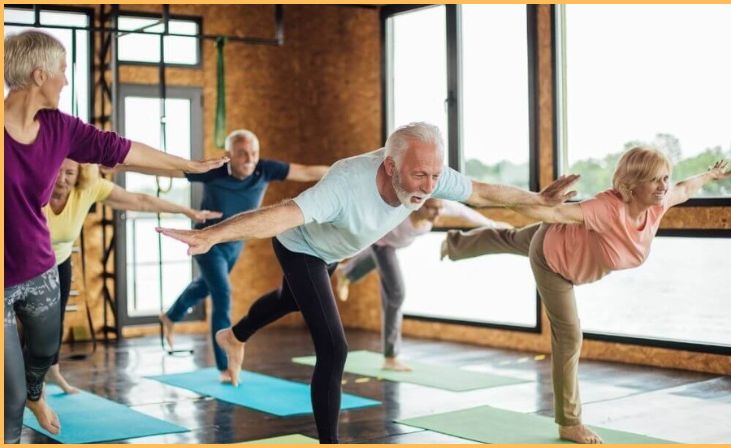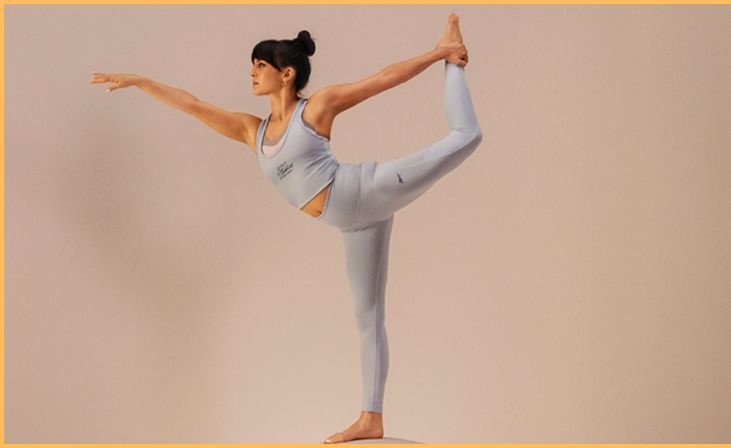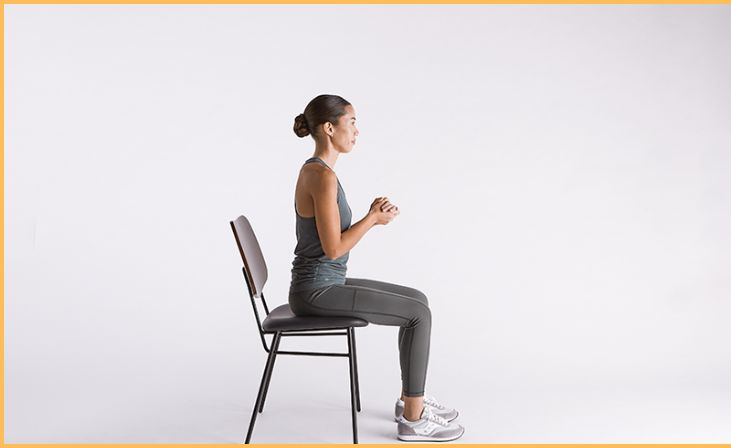Balance Exercises for Seniors – As we age, maintaining balance becomes increasingly vital for overall well-being and independence. Balance exercises for seniors play a crucial role in preventing falls, enhancing mobility, and promoting confidence in daily activities.
This comprehensive guide aims to provide a diverse range of balance exercises suitable for seniors, accommodating various fitness levels and abilities. The benefits extend beyond physical stability to encompass cognitive functions, as engaging in balance activities stimulates the mind-body connection.
Prioritizing safety, this program incorporates both standing and seated exercises, along with the use of stability balls, ensuring a holistic approach to improving balance. By integrating these exercises into a regular routine, seniors can proactively enhance their stability, flexibility, and overall quality of life.
Importance of balance for seniors

The importance of balance for seniors cannot be overstated, as it directly influences their overall well-being and quality of life. Aging often brings changes in muscle strength, joint flexibility, and sensory perception, which can contribute to a decline in balance. Maintaining a strong sense of balance is crucial for several reasons:
- Fall Prevention: Seniors are more susceptible to falls, and balance exercises can significantly reduce this risk. Enhancing stability helps prevent accidents, fractures, and other injuries associated with falls.
- Independence: Good balance allows seniors to perform daily activities with confidence and independence. Whether it’s walking, reaching for items, or getting up from a chair, a stable sense of balance is essential for maintaining autonomy.
- Mobility: Balance is integral to mobility. Seniors with good balance are more likely to move freely, engage in physical activities, and maintain an active lifestyle, contributing to overall health.
- Cognitive Health: Engaging in balance exercises stimulates cognitive functions by requiring focus, coordination, and spatial awareness. This connection between physical and cognitive abilities is vital for maintaining mental sharpness.
- Posture: Balance exercises can improve posture, reducing the risk of musculoskeletal issues. Maintaining an upright and aligned posture contributes to overall comfort and reduces the likelihood of back pain and related problems.
- Confidence: Successful balance training fosters confidence in seniors, encouraging them to participate in social activities, travel, and explore their surroundings without the fear of falling.
- Overall Well-Being: Balance exercises contribute to an overall sense of well-being. Physical activity releases endorphins, which can improve mood, reduce stress, and enhance the overall quality of life for seniors.
Also, Read – Benefits Of Yoga
Balance Exercises for Seniors
Single Leg Stands

Stand behind a chair, holding on for support. Lift one leg off the ground, keeping it straight, and hold the position for 10-30 seconds. Ensure your raised foot is slightly off the floor. Switch legs and repeat.
This exercise enhances leg strength, stability, and balance, crucial for preventing falls in seniors. Gradually increase the duration as your balance improves.
Always prioritize safety, and consult with a healthcare professional before starting any new exercise routine.
Heel-to-Toe Walk
Practice heel-to-toe walking to enhance balance. Begin by positioning the heel of one foot directly in front of the toes of the other. Take small steps, maintaining this heel-to-toe alignment. Engage your core muscles for stability.
This exercise simulates a challenging walking pattern, promoting coordination and improving balance. Initially, perform it near a support surface and, as confidence builds, attempt it in open spaces. Focus on a steady and controlled gait.
Consult with a healthcare professional before incorporating new exercises into your routine, ensuring they are suitable for your individual needs and health conditions.
Flamingo Stand

For the Flamingo Stand, use a sturdy surface for support. Lift one leg, bending it at the knee, and hold the position for 10-30 seconds. Maintain a straight posture and engage your core muscles. This exercise enhances balance and works on leg strength.
Ensure the supporting surface is within reach for added stability. Gradually increase the duration and try balancing without support as you become more confident.
Consult with a healthcare professional before starting any new exercise routine to ensure it aligns with your health needs and capabilities.
Also, Read – Effective SARMs Stacks for Muscle Building
Side Leg Raises
Stand behind a sturdy chair, holding on for support. Lift one leg to the side, keeping it straight, and then lower it back down. Repeat the movement on the other leg. This exercise targets the muscles on the sides of your hips and thighs, promoting better stability and balance.
Focus on controlled movements, keeping your torso upright. As you progress, you can increase the number of repetitions.
Ensure a safe environment, and consult with a healthcare professional before incorporating new exercises, especially if you have any existing health concerns or conditions.
Toe Taps

Stand with feet hip-width apart. Lift one foot and tap the toe on the ground in front, then to the side, and finally behind. Repeat on the other foot. This Toe Taps exercise improves balance, agility, and strengthens lower extremity muscles. Engage your core for stability throughout the movement.
Start with a slow and controlled pace, gradually increasing speed as you become more comfortable. Use a support if necessary and ensure a safe environment.
As with any new exercise, consult with a healthcare professional to determine its suitability for your individual needs and health condition.
Marching in Place
Marching in place is a simple yet effective balance exercise. Stand with good posture and lift your knees high, mimicking a marching motion. Engage your core muscles for stability. This exercise helps improve balance, leg strength, and coordination.
Start with a slow and controlled pace, gradually increasing the speed as you become more comfortable. You can perform this exercise anywhere with enough space.
If needed, use a support surface for balance. Always prioritize safety and consult with a healthcare professional before incorporating new exercises, especially if you have any existing health concerns or conditions.
Balancing Wand

For the Balancing Wand exercise, hold a broomstick or similar object in front of you. Lift one leg and hold it in the air while balancing on the other leg. Ensure a straight posture and engage your core muscles. Hold the position for 10-30 seconds and then switch legs.
This exercise improves balance, stability, and strengthens leg muscles. Start near a wall or sturdy surface for support, and as you progress, try balancing without assistance.
Gradually increase the duration for a more challenging workout. Prioritize safety, and consult with a healthcare professional before starting any new exercise routine, especially if you have pre-existing health conditions.
Clock Reach
Incorporate the Clock Reach exercise to enhance balance. Imagine standing in the center of a clock. Lift one leg and reach it forward to 12 o’clock, then to 3 o’clock, and finally to 6 o’clock. Keep movements controlled and precise. Switch legs and repeat.
This exercise engages various muscle groups, promoting stability and coordination. Initially, perform near a support surface, gradually attempting it in open spaces as confidence grows.
Consult a healthcare professional before adding new exercises to your routine, ensuring they align with your individual health needs and conditions. Consistency and gradual progression are key to reaping the benefits of this exercise.
Yoga Tree Pose

For the Yoga Tree Pose, stand near a wall for support if needed. Shift your weight to one foot and place the sole of the other foot on the inner thigh or calf of the standing leg. Avoid placing the foot on the knee. Bring your palms together in front of your chest or extend your arms overhead.
Focus on a fixed point for balance. Hold the pose for 10-30 seconds and switch legs. The Yoga Tree Pose improves balance, flexibility, and concentration.
Begin near a support surface and progress to practicing in open spaces as your stability improves. Consult with a healthcare professional before attempting new exercises.
Sit-to-Stand Exercises

Engage in sit-to-stand exercises to enhance leg strength and balance. Begin by sitting in a sturdy chair with your feet flat on the floor. Without using your hands, stand up and then sit back down. Repeat this motion 10-15 times.
This exercise targets the muscles used in rising from a seated position, promoting stability and mobility. Ensure proper posture and a controlled movement throughout.
As you build strength, gradually increase the number of repetitions. If needed, perform near a support surface. Consult with a healthcare professional before incorporating new exercises, especially if you have any pre-existing health conditions or concerns.
Conclusion
In conclusion, prioritizing balance exercises is paramount for seniors to safeguard against falls, sustain independence, and promote overall well-being. By integrating these exercises into their routines, seniors can enhance stability, confidence, and cognitive function.
The investment in maintaining balance not only prevents injuries but also fosters a fulfilling and active lifestyle, reinforcing the importance of proactive health measures as we age. It’s a small commitment with significant dividends, ensuring that seniors can continue to navigate life with strength, grace, and the assurance of a stable foundation.
FAQs
Yes, balance exercises can be adapted for various mobility levels. Seated exercises, stability balls, and gradual progression allow individuals with limited mobility to engage in effective balance training.
It is recommended for seniors to incorporate balance exercises into their routine at least two to three times per week. Consistency is key for maintaining and improving balance.
Safety is paramount. Seniors should use sturdy support when needed, choose a safe environment for exercises, and consult with healthcare professionals before starting a new fitness routine.

